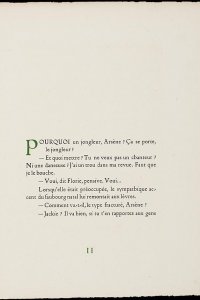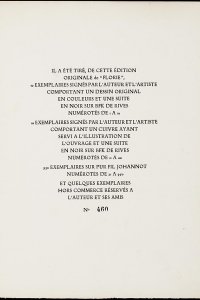Florie
Year: 1946
Author: Colette (1893 - 1954)
Artist: Louis Touchagues (1893 - 1974)
Publisher: Éditions de la Joie de vivre
No admission
Touchagues received the Légion d'honneur in 1948, an award that Colette had already received in 1920 (even becoming 'grand officier' in 1953). But another honour escaped her. Although she was made a member and even president of the Académie Goncourt in 1945, and had previously - in 1935 - joined the Académie royale de Belgique, she was not admitted to the Académie française because she was a woman. France would have to wait for any woman to be admitted to that group until 1980, when Marguerite Yourcenar was granted membership.
Just as she documented women's aging process, the photographers and artists documented Colette as she grew older. Whoever looks at the Album Pleïade- that unmatched iconographic series from publisher Gallimard- will see her changing from a good little girl into a seductive woman with flowers in her pinned-up hair, and from a scantily clad stage phenomenon into a grand old lady with a sharp look under a fluffy and impressive hairdo.
Bibliographical description
Description: Florie / Colette ; eaux-fortes de Louis Touchagues. - Cap d'Antibes : Éditions de la Joie de vivre, 1946. - [55] p. : ill. ; 32 cm
Printer: Audin (Lyon)
Edition: 950 copies
This copy: Number 460 of 930 on Johannot
Bibliography: In liefde verzameld-201 ; Monod 3005
Shelfmark: KW Koopm A 578
References
- Colette, Oeuvres, IV. Paris, Gallimard, 2001. (Bibliothèque de la Pléiade; 481)
- Hortense Dufour, Colette la vagabonde assise. Monaco, Rocher, 2000
- Nicole Ferrier-Caverivière, Colette l’authentique. Paris, Presses Universitaires de France, 1997
- Adele King, French women novelists: Defining a female style. Basingstoke, Macmillan, 1989
- Claude Pichois, Vincenette Pichois, Album Colette. Paris, Gallimard, 1984

![Ets door Louis Touchagues (p. [9])](/sites/default/files/styles/galerie/public/images/florie-p9.jpg?h=73d2fc1b&itok=7hjOenHy)

![Ets door Louis Touchagues (p. [25])](/sites/default/files/styles/galerie/public/images/florie-p25.jpg?h=259c4873&itok=-Qw9tQ4i)
![Ets door Louis Touchagues (p. [36])](/sites/default/files/styles/galerie/public/images/florie-p36.jpg?h=fac9c950&itok=ztqGUXmf)
